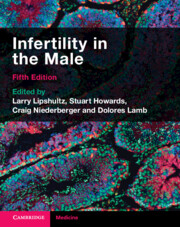Book contents
- Infertility in the Male
- Infertility in the Male
- Copyright page
- Contents
- Contributors
- Foreword
- Abbreviations
- Introduction
- Section 1 Scientific Foundations of Male Infertility
- Section 2 Clinical Evaluation of the Infertile Male
- Section 3 Laboratory Diagnosis of Male Infertility
- Section 4 Treatment of Male Infertility
- Chapter 21 Medical Treatment of Male Infertility
- Chapter 22 Surgery to Improve Sperm Delivery
- Chapter 23 Sperm Retrieval Surgery
- Chapter 24 The Use of Sperm in Medically Assisted Reproduction
- Chapter 25 Male Oncofertility – Considerations for Fertility Preservation and Restoration
- Chapter 26 Male Contraception
- Chapter 27 Future Directions in Male Infertility
- Section 5 Health Care Systems and Culture
- Index
- References
Chapter 25 - Male Oncofertility – Considerations for Fertility Preservation and Restoration
from Section 4 - Treatment of Male Infertility
Published online by Cambridge University Press: 08 July 2023
- Infertility in the Male
- Infertility in the Male
- Copyright page
- Contents
- Contributors
- Foreword
- Abbreviations
- Introduction
- Section 1 Scientific Foundations of Male Infertility
- Section 2 Clinical Evaluation of the Infertile Male
- Section 3 Laboratory Diagnosis of Male Infertility
- Section 4 Treatment of Male Infertility
- Chapter 21 Medical Treatment of Male Infertility
- Chapter 22 Surgery to Improve Sperm Delivery
- Chapter 23 Sperm Retrieval Surgery
- Chapter 24 The Use of Sperm in Medically Assisted Reproduction
- Chapter 25 Male Oncofertility – Considerations for Fertility Preservation and Restoration
- Chapter 26 Male Contraception
- Chapter 27 Future Directions in Male Infertility
- Section 5 Health Care Systems and Culture
- Index
- References
Summary
Over the last few decades, cancer incidence has increased in the United States. Many patients diagnosed with cancer are young, with nearly 10 percent below the age of 45 years and 1 percent below the age of 20 years [1]. Specifically for males aged between 15 and 19 years, cancer incidence has increased annually by 0.67 percent, resulting in >25 percent increase over 40 years [2]. Despite, the rise in cancer incidence, cancer survival has also dramatically improved, largely due to earlier detection and better treatments. With a growing number of chronic cancer survivors, there is focus on a concept termed cancer survivorship. Cancer survivorship focuses on maintaining and enhancing wellness in cancer survivors and on optimizing management of long-term side effects of their cancer and cancer treatments [3, 4].
- Type
- Chapter
- Information
- Infertility in the Male , pp. 461 - 476Publisher: Cambridge University PressPrint publication year: 2023



